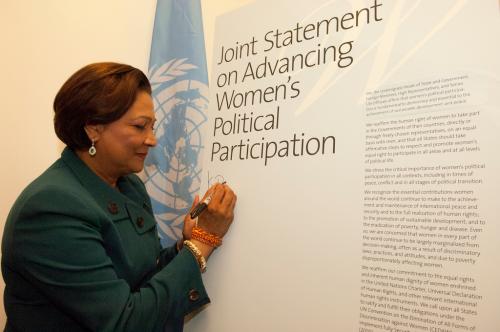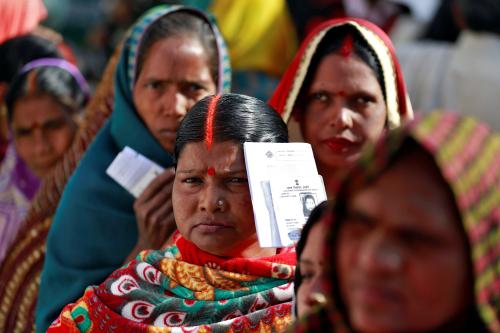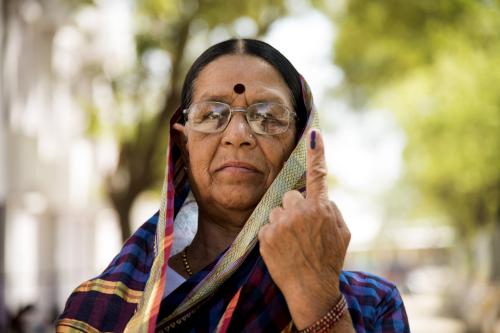Content from the Brookings Institution India Center is now archived. After seven years of an impactful partnership, as of September 11, 2020, Brookings India is now the Centre for Social and Economic Progress, an independent public policy institution based in India.
The following blog post is based on “Women in Party Politics,” a 2014 working paper by Shamika Ravi & Rohan Sandhu. In particular, it focuses on international experience with different policy designs when it comes to political reservation for women and the implications this has on political inclusion of women.
Globally, women remain vastly underrepresented in local and national politics. As of 2018, according to the Inter Parliamentary Union, only 24%[i] of parliamentarians are women. Can public policy, in general, and affirmative action, in particular, result in political inclusion of women? Data from the International Institute for Democratic and Electoral Assistance, Stockholm (IDEA) shows that an increasing number of countries around the world have introduced some sort of affirmative action for women in public office.
Besides reserving a minimum number of seats in elected national and state offices, gender-based quotas can also be introduced in candidate lists. While both forms of quotas can be legislated, the later can also be taken up by individual parties by amending their party constitutions. This blog seeks to highlight how quotas designed differently result in differential results.
Ravi and Sandhu (2014) study the case of Pakistan and South Africa to highlight contrasting international experiences:
Case 1: Quota at national assembly level | Pakistan’s experience and early warning signs
Starting from the Philippines in the early 1990s, a number of nations, including India’s neighbours Pakistan and Bangladesh, enacted legislations to reserve seats in their Parliaments to ensure female political inclusion.
However, while reservation increases the number of female candidates nominated by parties, they are almost exclusively concentrated amongst reserved seats. This implies that parties would then, more exclusively, tend to field male candidates in general seats. A similar trend has been witnessed in Pakistan, where after 2002, 17% of the seats in the National Assembly were reserved for women.
In her work, Huma Yusuf, Pakistani policy analyst and columnist, found that while the aggregate level of female candidates contesting elections from general seats has gone up to 108 (2013) from 76 (2008), only 36 of them contested through a political party. Two major political parties, the Pakistan People’s Party and the Pakistan Muslim League (Q) gave fewer tickets to women contestants for general seats in 2013 compared to 2008. In conclusion, in the absence of a rich pool of women candidates, reservation policy would accomplish little more than tokenism.
Case 2: Quota in candidate lists | South African Experience and Strong Positive Externalities
Alternatively, starting from Argentina, in the early 1990s, a number of nations including neighbouring Nepal, adopted a minimum quota in party candidate lists. Quotas as high as 50% of the candidate list have been passed in countries like France, Korea and Nepal, among others. Countries like Argentina, Mexico and Costa Rica, have legislated party quotas and have over 36% female representation in their national legislatures. However, similar levels of female representation have been achieved by countries like South Africa, Sweden and Germany through voluntary (non-legislated) quotas by political parties. South Africa serves as an excellent example with women comprising 44.8% of its current National Assembly.
In South Africa, the country’s biggest political party, the African National Congress (ANC), started discussions on quotas for women in 1991. By 1994, 35.7 %of representatives elected by ANC were women. This resulted in the National assembly having 25% representation by women. By the election in 2009, the ANC committed to increasing representation to 50% and this translated into the South African National Assembly having a 49.2% female representation.
This triumphant feat was achieved by a single party voluntarily opting for such quota, the ripple effects of which, further resulted in a significant positive externality on the opposition parties. While in 1994, women constituted 14.2%of the opposition, by 2009 this composition had doubled to 31% percent.
This, of course, underlines the significance of women’s movements within the parties. Women’s quota in the ANC largely emerged from the women’s movement within the ANC. The ANC’s Women League proactively brought together a number of organisations to create a charter to address issues important to women. The league continues to play an increasingly important role in the ANC.
Takeaways for India:
In a national context, India performs far worse compared to the global average of 22%[ii] (as of 2014) with only 11.42% women in its national assembly (2014-19) [iii]. While India lags behind, it has the advantage to learn from global experience. It has the benefit to improve upon both design and implementation of such a quota to achieve more efficient outcomes. In determining which of the two systems of reservation works better, IDEA summarises that, “in almost all political systems, no matter what electoral regime, it is the political parties, not the voters that constitute the real gatekeeper to elected offices.”
Hence, Indian political parties must realise their critical role as gatekeepers in women’s political participation. Fundamental reforms at the party level will serve as a necessary and strategic compliment to the Women’s Reservation Bill. Even if the bill is derailed further, it should not stop political parties from making internal structures more conducive to women entering politics. These measures will ensure that the passing of the bill does not translate to mere tokenism and results in true empowerment of the Indian women.
[i] https://data.worldbank.org/indicator/sg.gen.parl.zs
[ii] https://data.worldbank.org/indicator/sg.gen.parl.zs
[iii] https://eci.gov.in/files/file/2812-participation-of-women-candidates-in-poll/
The Brookings Institution is committed to quality, independence, and impact.
We are supported by a diverse array of funders. In line with our values and policies, each Brookings publication represents the sole views of its author(s).






Commentary
Women’s Reservation Bill: What can India learn from other countries?
October 18, 2019